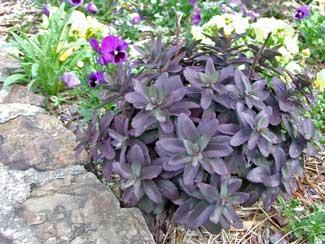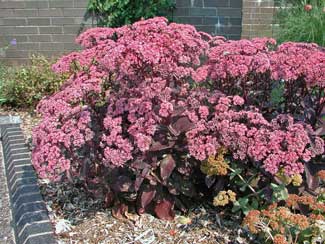Resource Library
Plant of the Week: Stonecrop Sedum
The University of Arkansas System Division of Agriculture does not promote, support or recommend plants featured in "Plant of the Week." Please consult your local Extension office for plants suitable for your region.
Plant of the Week
Stonecrop Sedum
Latin: Sedum hylotelephiium

As I’ve gotten older I find change harder to accept. Plant names change frequently – too frequently for my taste in fact – and sometimes they seem to make little sense. This week, I’ll discuss a new plant name, Hylotelephium telephium, which used to be classified under the more familiar name Sedum telephium. Though I bemoan the change, it makes a lot of sense if you look into the research that went into the change.
Hylotelephium telephium and the closely related H. spectabile, and their many hybrids, are the most important of the stonecrops in the new genus. They are clump-forming herbaceous perennials with stout, upright stems to 2 feet tall with fleshy, tuberous roots. The leaves tend to be large and leathery but not rotund as is found in many species of sedum. In hybrids such as ‘Black Jack,’ the epidermis of the leaf is a deep maroon-black color. The popular green-leafed ‘Autumn Joy’ is now correctly classified under the new name.
Flowers are produced under short day conditions of late summer and are in terminal cymes 4 to 5 inches across. The flowers are typically pink to rose-colored, but sometime whitish-silver in some cultivars. Individual flowers are star shaped and to a half-inch across with an upright central column of flower parts. Flower heads look like a green bunch of broccoli before they open then take on the typical flower color for the species which remains effective for three weeks, and then the seed capsules develop and provide an effective display that many people find handsome through the winter.
The new genus Hylotelephium was first proposed in 1977 by a Japanese scientist, but the change was not immediately accepted. But over the past 35 years, a number of scientists throughout the world have been studying the classification of the Crassulaceae, a widely distributed family of succulents consisting of about 33 genera and 1,400 species. My suspicion for why these succulents are such favorites for study is that botanists don’t always have the greenest thumbs and it is easy to keep them alive while they pursue their research. But for whatever reason, they have been thoroughly reviewed at the morphological, chemo-taxonomic, geographic, genetic and molecular level. What they found was that plants in some old, well established genera such as Sedum simply weren’t as closely related as older taxonomies indicated.

Henk ‘t Hart (1944-2000), a taxonomist interested in how new species evolved, worked at Utrecht University in the Netherlands and was perhaps the leading expert on the evolutionary history of sedums and the Crassulaceae. He did extensive studies of on hybridization within the genus Sedum to determine relationships between the European species and, from this and DNA analysis, conclusively demonstrated the split off of the 35 species to create the new genus Hylotelephium was a sound scientific move.
So, if you prowl the web looking for information about your favorite upright sedums, you will find about half the websites list the plant under the old name and half use the new name. Gardeners and nurserymen are slower to accept new names so it may take another generation or two to have the change be accepted. But regardless of what they are called, they are great plants for the garden.
Stonecrops are good plants for massing in the sunny border or for use as accents in the front of a mixed shrub planting. They tolerate a wide array of soil types and are very drought tolerant. Propagation is easy by springtime division.
By: Gerald Klingaman, retired
Retired Extension Horticulturist - Ornamentals
Extension News - August 30, 2013
The University of Arkansas System Division of Agriculture does not maintain lists of retail outlets where these plants can be purchased. Please check your local nursery or other retail outlets to ask about the availability of these plants for your growing area.